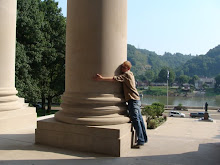 My thoughts on New Orleans
My thoughts on New Orleans and the 2011 Society of Architectural Historians conference. 




It's been almost a month since my last
post,
and for that I apologize. I have been dedicating most of my time(well all of it) to my undergraduate thesis. I'm hoping to produce research, a paper, a dialogue(well something) that will actually contribute to the field.
I spent the weekend in New Orleans, LA. I must admit that my understanding of where N'awlins fits in the context of American history(before this weekend) was somewhat lacking. I will also say that I have NEVER learned so much or had my perspective changed so much in a few days time.
Aside from the several paper sessions that I was able to attend, which inspire me to contribute, often it was through my own exploration of the city's many districts and quarters that my understanding of place was shaped. I would describe the city as a product of French colonialism, Spanish colonialism, street car suburbia, CaribbeaN cultural exchange, SHIPPING, a handful of complex social issues, and garnished with a mind numbing natural disaster that
has changed everything... The more I saw and read the more I came to understand it as a palimpsest. The layers are so deeply connected, that some were so complex that they can't even begin to be sorted
out. The cultural mix truly results in something uniquely awesome. There is much still to be said about the city of NEW ORLEANS.
The most memorable parts of the city in terms of architecture-for me at least-would be the French Quarter. Perhaps most known for being the oldest remaining part of the city, its shotgun houses, and creole cottages are irresistibly quaint. They are what I envision when I think of the city. Separating deep history from Garden district suburbia is the building district with it's boxy modern and post modern skyscrapers.
The Garden District. By far one of the most interesting street-
scapes in America. With both lanes of vehicular traffic flanking a central green-space with grass, trees, and a streetcar line that is the oldest continually running streetcar line in the world.
(It was very interesting-I might add-seeing school kids using the streetcar
to get home as well as workers, and college students. The line runs directly past Loyola and Tulane Universities.)
Finally, The Lower Ninth Ward. It'll be six years
after Katrina, and the lower ninth ward still seems to be struggling in some ways to regain a feeling of foundation. It was the first time I had been there in my life, or seen it, other than seeing
the Ward
and streets on the news during the catastrophe itself. It was fascinating how much I felt still needed to be done. Many of the reminders of the tragedy are still very prominent such as spray painted body count markers on house doors and walls. This was just a very small reminder, but also a very grim one. This was something that stuck on my mind even during the car ride home.
As I left the city I felt like so much is needed to be
written about it, and so many issues could be discussed.
Here are a few of my photos-I'll try not to let it be another month before my next blog.








No comments:
Post a Comment